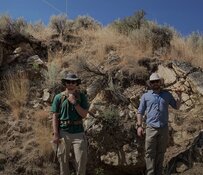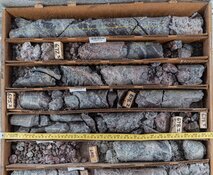TICKERS: AMY; AMYZ; 2AM, AVL; AVARF, NEM, ROC
Rare Earth Metals that Fit the Trends: Marcel Fuhrer
Interview
Source: Brian Sylvester of The Critical Metals Report (1/17/12)
 Success in the critical metals sector depends on finding the trends—how the metals will be used, where market share is allocated—and on familiarity with the companies you invest in, from who is on the management team to how much cash they have on hand. Bamert & Partner Portfolio Manager and Partner Marcel Fuhrer shares his views in this exclusive Critical Metals Report interview.
Success in the critical metals sector depends on finding the trends—how the metals will be used, where market share is allocated—and on familiarity with the companies you invest in, from who is on the management team to how much cash they have on hand. Bamert & Partner Portfolio Manager and Partner Marcel Fuhrer shares his views in this exclusive Critical Metals Report interview.
Marcel Fuhrer: Including 2011, the average rate of return over five years was 7% per annum. In 2011, it was down 30%.
TCMR: Is the sustained volatility in global markets causing you concern?
MF: Yes, absolutely. It hurts the development of companies that need to raise capital to go forward with their projects. Such long periods of volatility also make investors shy away.
TCMR: In a previous life you were with Dexia Bank, so I would like to ask you about the European Central Bank's (ECB) offer of bank loans totaling $640 billion (B) to European banks in late December 2011. While those loans may stabilize banks and make it easier for them to lend to businesses, they will do little to solve the root problems of Europe's financial woes—heavily indebted nations facing unsustainable borrowing costs. What is your perspective on the ECB's action?
MF: My opinion is that the ECB has to continue to provide the liquidity needed by the banking system because the ultimate goal must be to avoid a liquidity crunch like we saw in 2008, which led to a very deep and fast recession worldwide.
I think other central banks, and not only in Europe, will continue to work on liquidity and to buy time for the Europeans to solve their issues.
TCMR: Do you believe the actions taken by the American government in 2008 artificially propped up Europe's economy? It might be said that the European economy is now experiencing what it should have experienced a few years ago.
MF: It is likely that the subprime crisis in the U.S. has given us some insight into the troubles that are now apparent in Europe, such as the big differences between the countries in the south and those in the north.
Germany, for example, was not forced to prop up its liquidity or put money into its economy during 2008 and 2009. The weaker economies, however, had to do that and that load has now exploded. This is what led to the European debt crisis, in which we are now living. For a long time, the European Union was able to hide these divergences. That is not the case anymore.
TCMR: What's your view on the Eurozone? Do you believe it will last? Was it a good idea?
MF: The idea actually is good, but there should have been more unification before the currency went into effect. They put in a unified currency thinking that would unify a lot of different cultures and different ways of doing business. Other types of unification should have come first. So, the idea is good but the timing was not.
TCMR: Given sovereign debt problems in the Eurozone and widespread investor uncertainty there, is it now more difficult to manage a fund based in Europe than it was a few years ago?
MF: Given the markets and investor behavior, it is more difficult. But that is really a global phenomenon, not the result of the European situation. The real issues are financial globalization and the higher correlations we have to live with. That is what gives us a harder time managing money.
TCMR: Can you point to anything specific that you are dealing with now that you did not have to deal with prior to 2008?
MF: We have to be very keen on making sure that the companies we invest in, particularly in the exploration space, have sufficient capital or access to capital to meet important milestones on their projects. They cannot run out of cash and go away. This timeframe has shortened a lot in the last couple of years.
The other thing, as we discussed earlier, is the huge volatility, particularly to the downside. That is obviously not helpful at all.
TCMR: Has the cycle of turning fiat currencies into hard assets run its course or is there significant momentum left?
MF: It still has a ways to go. With the current uncertainties in the financial markets, the European debt crisis and the risk aversion that has come back the last couple of months; the strength of the U.S. dollar has basically stopped the process. I assume this will be only temporary, because the U.S. dollar is a fiat currency itself and it will take its course.
TCMR: Are you sitting with a large cash position right now?
MF: Yes, for the time being, we have a larger cash position than usual.
TCMR: What sort of opportunities are you seeking in the rare earth metals space?
MF: We are seeking companies that have projects or products that fit in with what we see as future developments or trends; companies we believe in and that offer a certain value given where they are priced by the market. Even if a company fell off a lot, if we see that there is a floor given its cash position or the valuation of its resource in the ground, we see it as an opportunity.
TCMR: What are some major trends in the sector?
MF: We see, for instance, a transition in the Chinese resource space. We believe that given the more strict regulations, there is a trend toward lower outputs from China. That is a trend that will last.
We also are looking at the battery market, where we see a big jump for the resources linked to the production of these batteries.
TCMR: More and more, resource companies listed on the TSX and TSX Venture, are now dual listed on the DAX, the Frankfurt Exchange. It is becoming popular for junior mining companies to conduct European road shows to raise capital in London, Frankfurt and Zurich. Why is this happening now? Are these juniors just learning that investors have strong appetites for resource plays?
MF: I have been doing this now for 15 years in the resource space; there were always companies visiting here, although obviously not as many as today. In general, I think the fight for capital has increased a lot. Companies are engaging marketing people; they have investor relations managers. European financial centers are places of interest to these companies. The third driver is the commodity prices themselves, which have been very good in recent years.
TCMR: How much of the $150 million fund that you run is allocated to resource plays?
MF: It probably is around 15% allocated to resource plays, so quite a lot.
TCMR: And which commodities are represented in that 15%?
MF: We have a number of gold stocks in our portfolio and some copper. We also have American Manganese Inc. (AMY:TSX.V; AMYZ:OTCPK; 2AM:FSE). I also like lithium a lot as a resource.
TCMR: Why did you choose American Manganese?
MF: We believe this is quite a unique project, located in Arizona. It is a proven resource that was widely used during the Second World War. Given that Chinese output of manganese is going to decline, there is a good chance that American Manganese can take over some of that market share. We are pretty close to the company and are well informed. We believe management does a good job and the infrastructure looks very easy to access. These are the main reasons we believe in this story.
TCMR: Worldwide demand for electrolytic manganese, which is what American Manganese is slated to produce from its Artillery Peak Project in Mohave County, Arizona, is going to double during the next decade. Is that reason enough to own that company?
MF: No, I do not think so. Obviously, that is of great importance. But, even if the growth is not that big, I believe the low-cost structure of American Manganese's project can easily compete with Chinese producers and deliver its electrolytic manganese to American steel producers.
TCMR: Are there other resource plays you would like to tell us about today?
MF: One that we have just started to get involved in is Talison Lithium Ltd. (TLH:TSX). It is the largest producer of lithium. The company has one project in Australia already in production and another one in Chile. Our interest here goes along with the trend of battery-powered cars, which are on their way now and will last for many, many years to come.
TCMR: How did you learn about Talison and what is the catalyst for taking a position?
MF: I first got interested in the battery field through a company called Polypore, which actually transforms the lithium into the form needed to produce these batteries. Polypore is a great success story.
I dug a little further to see where the lithium was coming from and found Talison. Talison is not diversified, is already in production and has very good partners in Japan to buy its lithium.
TCMR: Is there another metal or rare earth element (REE) that you see as part of a demand trend over the next 10 years?
MF: We got into rare earths quite early, and actually started to sell some of those positions last year. But I am still am very much looking at Neo Material Technologies (NEM:TSX). This company is not a producer; it is more like a Polypore. It transforms the rare earths into the alloys that then go on to the end-user. It is really a separation company. It is based in Canada, but its facilities are in China.
TCMR: Are you invested in any other REE plays?
MF: We have been with Talison Lithium for many, many years. It is a solid project, quite advanced now. However, issues remain about getting the metals processed and about raising capital. Avalon has a very high capital expenditure. The good thing is that it is mostly a heavy rare earth project, and we believe prices will be more sustainable in the heavy rare earths. If I were to invest again in that space, I would focus on such a project.
TCMR: We saw a pullback across the board in equity prices among the juniors throughout the latter half of 2011. The REE sector was one of the harder hit. Are you looking to take some positions in other companies as these shares languish near their all-time lows?
MF: One has to be really careful; there are probably a bunch of projects out there that will never be realized. It is important to get to know the projects and the management very well. Investors need to feel very comfortable nowadays to really get involved in such companies. So, I believe I would rather increase my position in Neo Material or Avalon.
TCMR: You are right; it is best to look at a company's fundamentals, at its management team and its track record. What is your forecast for junior resource plays going into 2012?
MF: I believe 2012 will be a pretty OK year for the world economy and for commodities. The European debt crisis will probably be prominent in the first half of the year, given the huge need for financing. If European countries are able to get all the money they need, I think the market will normalize and the focus will go back to fundamentals.
I believe the resource projects all look pretty good. They will all stand and fall with the risk aversion that characterizes financial markets. So, let's say I am partly optimistic.
TCMR: Marcel, thank you for your time and your insights.
Marcel Fuhrer, partner, is responsible for the technical portfolio management and the strategic analyses at Bamert & Partner. After training at the SUISSECredit Suisse Group, he acquired further experience as a securities trader at an asset management company in Zurich, followed by a 15-year period as portfolio manager with Dexia Privatebank (Switzerland). Fuhrer acted also as a member of Dexia's Investment Committee. He has a diploma degree as a Chartered European Financial Analyst.
Want to read more exclusive Critical Metals Report articles like this? Sign up for our free e-newsletter, and you'll learn when new articles have been published. To see a list of recent interviews with industry analysts and commentators and learn more about critical metals companies, visit our Critical Metals Report page.
DISCLOSURE:
1) Brian Sylvester of The Critical Metals Report conducted this interview. He personally and/or his family own shares of the following companies mentioned in this interview: None.
2) The following companies mentioned in the interview are sponsors of The Critical Metals Report: American Manganese and Talison Lithium. Streetwise Reports does not accept stock in exchange for services.
3) Marcel Fuhrer: I personally and/or my family own shares of the following companies mentioned in this interview: American Manganese Inc. and Avalon Rare Metals. I personally and/or my family am paid by the following companies mentioned in this interview: None. I was not paid by Streetwise for participating in this story.



































